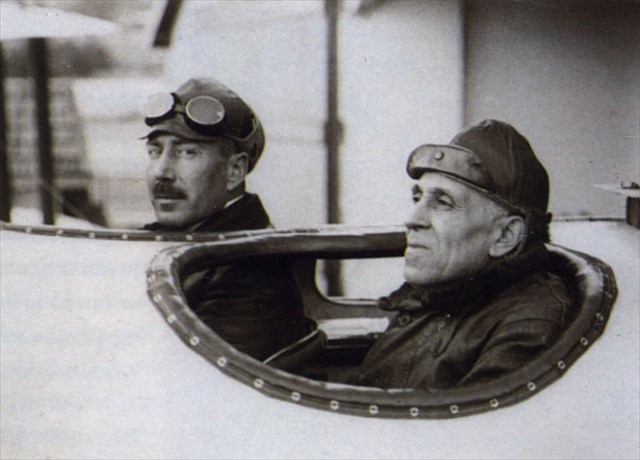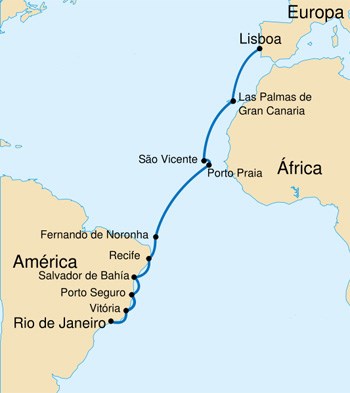
March 30th 1922, 4.30h p.m. – on this date, a pair of Portuguese aviators, Sacadura Cabral and Gago Coutinho, set off on the first flight across the South Atlantic, from Lisboa to Recife (Brazil). They made it, but with plenty of down time for repairs and waiting on replacement aircraft. The 8088-km journey ended on June 17th, after 79 days totalizing 62 hours of effective flying time.

|
Sacadura Cabral (left) and Gago Coutinho
|
The first stage of the journey was concluded on this same day, without incidents, in Las Palmas, Canary Islands, although both have noticed excessive fuel consumption on their original Fairey III D hydroplane Lusitania.
On April 5th, they left towards the island of São Vicente in the archipelago of Cabo Verde, covering 1360 km. They stayed there until April 17th to repair the seaplane – which was having problems on the floats – and left on the following day towards the archipelago of São Pedro and São Paulo in Brazilian waters. The waving sea at that place, however, caused real damage to the Lusitania, which lost one of its floats. The aviators were rescued by a Portuguese Navy Cruiser, which took them to the island of Fernando de Noronha. Although exhausted by the flight of 1700 km and the rough landing, they celebrated the occasion, as they were able to mark with high precision the finding of sea rocks in the South Atlantic, with the use of the method of celestial navigation created by Gago Coutinho.

|
Route of the first flight across the South Atlantic
|
With the Portuguese and Brazilian public opinion involved in the achievement, the Portuguese government sent another Fairey hydroplane by the Brazilian ship Bagé, baptized as Lusitania II, which arrived on May 6th. Five days later, at May 11th, they finally left Fernando de Noronha. However, a new incident was about to happen: just after returning to archipelago of São Pedro and São Paulo to fly over the interrupted sector, serious problems on the engine forced them to make an emergency landing on the sea, where they remained for nine hours, until they were rescued by an English freighter - the Paris City, on transit in the region.
Back to Fernando de Noronha, they waited until June 5th, when they were sent a new Fairey III-D, baptized as Santa Cruz by the wife of the President of Brazil, Epitácio Pessoa (1919-1922). Brought by the Portuguese ship Carvalho Araújo, it was placed in the waters of the archipelago of São Pedro and São Paulo, and took off towards Recife, and then making stops in Salvador da Baía, Porto Seguro, Vitória, and from here to Rio de Janeiro, the Federal Capital, where they finally landed on June 17th.

Enthusiastically acclaimed as heroes in all Brazilian cities where they stopped, the aviators had not only successfully completed the first flight across the South Atlantic, but also, for the first time in the history of aviation, it had been possible to travel over the Atlantic Ocean with solely the aid of astronomical navigation from the airplane.
The journey became the inspiration for the subsequent trips of Sarmento de Beires, João Ribeiro de Barros and Charles Lindbergh, all in 1927.
Watch the short video of the preparation of the journey as well of the aviators triumphal arrival to Lisboa.
====================================================
The Cache
At the given coordinates you will find a real-scale replica of the Fairey III-D Santa Cruz, the hydroplane that took Gago Coutinho and Sacadura Cabral on the last leg of their journey. Walk around the plane and take note of some details, as you will need them to proceed to the final stage:
(A) The number of Crosses of the Order of Christ;
(B) The number of national shields;
(C) The number of sponsors (engraved on stone) that were involved in the construction of the structure;
(D) The year written on small plaque attached to one of the floats;
(E) The total number of large hexagonal screws on the external side of the floats;
Then perform these simple calculations:
U = E / B
V = A + 1
W = C - E + 1
X = (D / 181) - 5
Y = A + B +1
Z = C - B - E
The cache can be found at N 38º 41.UVW; W 9º 12.XYZ
Remarks:
- Please be very stealth when searching for this cache.
- The cache has no writing material, so please bring your own one.
- Pictures at stage1 may be posted as long as they do not show spoilers.

30 de Março de 1922, 16h30 – nesta data, dois aviadores Portugueses, Sacadura Cabral e Gago Coutinho, partiram no primeiro voo sobre o Atlântico Sul, de Lisboa até ao Recife (Brasil). Apesar de terem perdido bastante tempo em reparações e esperas de aeronaves de substituição, o feito foi finalmente conseguido em 17 de Junho, após 8088 km em 79 dias que se traduziram em 62 horas de voo efectivo.
A primeira etapa da viagem foi concluída no mesmo dia da partida, sem qualquer incidente, em Las Palmas, Ilhas Canárias, embora ambos tenham notado um consumo excessivo de combustível no seu hidroavião Fairey III D Lusitania.
No dia 5 de Abril, partiram para a ilha de São Vicente, no arquipélago de Cabo Verde, cobrindo 1360 km. Aí ficaram até dia 17 para reparações no hidroavião ao nível dos flutuadores, tendo partido no dia seguinte em direcção ao arquipélago de São Pedro e São Paulo, já em águas brasileiras. O mar encrespado e a forte ondulação daquelas águas causaram no entanto um dano mais grave no Lusitania, que assim perdeu um dos flutuadores. O aviadores que entretanto foram resgatados por um cruzador da Marinha Portuguesa, foram levados para a ilha de Fernando de Noronha. Embora exaustos pelo voo de 1700 km e pela difícil aterragem, o momento foi grandemente comemorado pelo facto de terem descoberto e posteriormente marcado com elevada precisão utilizando o método de navegação astronómica criado por Gago Coutinho, a ocorrência de pequenas massas rochosas no Atlântico Sul.
Com a opinião pública portuguesa e brasileira envolvida na realização do feito, o Governo Português acabou por enviar hidroavião Fairey, baptizado de Lusitania II, através do navio brasileiro Bagé, , que chegou ao local no dia 6 de Maio. Cinco dias depois, no dia 11 de Maio, os aviadores deixaram finalmente para trás a ilha de Fernando de Noronha. No entanto, um novo incidente estava prestes a acontecer: logo após de retornarem ao arquipélago de São Pedro e São Paulo para voar sobre o sector interrompido, graves problemas no motor forçaram a uma nova aterragem de emergência no mar, onde permaneceram durante nove horas , até que finalmente foram resgatados por um cargueiro Inglês, o City of Paris, em trânsito naquele sector.
De volta à ilha de Fernando de Noronha, ali esperaram até dia 5 de Junho, quando receberam um novo Fairey III-D, baptizado de Santa Cruz pela esposa do Presidente do Brasil, Epitácio Pessoa (1919-1922). O hidroavião foi entretanto colocado nas águas do arquipélago de São Pedro e São Paulo pelo navio português Carvalho Araújo, tendo finalmente os aviadores partido para o Recife, fazendo depois escalas em Salvador da Baía, Porto Seguro, Vitória, e daqui para o Rio de Janeiro, a capital federal, onde finalmente aterraram no dia 17 de Junho.
Entusiasticamente aclamados como heróis em todas as cidades brasileiras onde pararam, os aviadores não só haviam completado com êxito o primeiro voo sobre o Atlântico Sul, mas também, pela primeira vez na história da aviação, tinha sido possível viajar sobre o Oceano Atlântico com apenas o auxílio da navegação astronómica a partir do hidroavião.
O feito conseguido constitui o motivo de inspiração para as viagens de Sarmento de Beires, João Ribeiro de Barros e de Charles Lindbergh, todas em 1927.
Veja o curto vídeo da preparação da viagem bem como da chegada triunfal dos aviadores a Lisboa.
====================================================
A Cache
Nas coordenadas iniciais irá encontrar uma réplica em escala real do Fairey III-D Santa Cruz, o hidroavião que transportou Gago Coutinho e Sacadura Cabral na última etapa de sua memorável viagem pelo Atlântico Sul. Dê uma volta em redor do hidroavião e tome nota de alguns detalhes que serão necessários para obter as coordenadas finais:
(A) O número de Cruzes da Ordem de Cristo;
(B) O número de escudos nacionais;
(C) O número de patrocinadores (gravados em pedra) que estiveram envolvidos na construção da réplica;
(D) O ano gravado numa pequena placa que se encontra num dos flutuadores;
(E) O número total de parafusos largos de forma hexagonal no lado exterior dos flutuadores;
Agora efectue estes cálculos simples:
U = E / B
V = A + 1
W = C - E + 1
X = (D / 181) - 5
Y = A + B +1
Z = C - B - E
A cache encontra-se em N 38º 41.UVW; W 9º 12.XYZ
Recomendações:
- Por favor seja muito discreto na procura da cache.
- Traga material de escrita.
- Podem ser publicadas fotos do 1º ponto desde que não contenham spoilers.